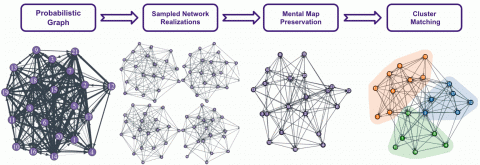Description
Clinical radiotherapy (RT) treatment planning systems [1] enable radiotherapists and oncologists to decide on the most optimal treatment course for brain cancer patients. However, data uncertainties introduced throughout the pipeline pose a challenge to providing the users with a comprehensive perception of the radiation dose exposure to brain structures.
In this project, we aim to use network graphs to visualize uncertainties in an RT plan, enabling the users to perceive data uncertainties better and make a more confident treatment course decision. We anticipate two challenges. First, uncertainties accumulate throughout the pipeline of RT treatment planning [2]. The visual space provides a limitation to introducing new encoding of information layers. The conventional visualization in the field relies on multimodal and multilayered data. For example, the conventional dose-slice view represents dose values with a rainbow color scale and the organ with a grayscale piling dozens to hundreds of slices to be explored. Representing the uncertainty of the dose adds another visual layer; thus, it adds perceptual complexity. Network graphs are agile in the encoding and representation of data. Second, conventional RT planning systems used in clinics today do not enable the simultaneous comparison of treatment plans. Typically, plans are explored independently, and then, the therapy plan of interest is examined in more detail separately. Clinicians prefer this approach due to the complexity of the represented data. Comparing networks could provide a space for efficient comparison of two or more plans [3]. Using network graphs to reduce and simultaneously compare plans uncertainty has not been researched to our knowledge.
Tasks
In this project, you will be tasked with implementing a semi-automatic solution to visualize uncertainty clinical data as a network graph. You will conduct a study to demonstrate the validity of the approach.
Requirements
- Knowledge of English language (source code comments and final report should be in English)
- Knowledge of Python or comparable programming languages is advantageous
- Interest in network graphs and the clinical domain
Environment
The project should be implemented as a standalone application, desktop or web-based (to be discussed).
References
[1] M. Rahman, M. R. Ashraf, D. J. Gladstone, P. Bruza, L. A. Jarvis, P. E. Schaner, X. Cao, B. W. Pogue, P. J. Hoopes, and R. Zhang. Treatment Planning System for Electron FLASH Radiation Therapy: Open-Source for Clinical Implementation. International Journal of Radiation Oncology, Biology, Physics, 112(4):1023-1032, 2022.
[2] M. Schlachter, R.G. Raidou, L.P. Muren, B. Preim, P.M. Putora, and K. Bühler. State-of-the-Art Report: Visual Computing in Radiation Therapy Planning. Computer Graphics Forum, 38: 753-779. 2019. https://doi.org/10.1111/cgf.13726.
[3] P. Wills and F. G. Meyer. Metrics for graph comparison: A practitioner’s guide. PLOS ONE, 15(2):1-54, 2020.
